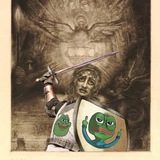Testosterone X Men's Health and Behavior
10 Facts
Source https://www.group-telegram.com/AlessandroLoiola/6868
10 Facts
Source https://www.group-telegram.com/AlessandroLoiola/6868
Pierre Jean van der Ouderaa - The King of Thule, 1896
The Roman poet Silius Italicus (AD 25 – 101) wrote that the people of Thule were painted blue: "the blue-painted native of Thule, when he fights, drives around the close-packed ranks in his scythe-bearing chariot", implying a link to the Picts (whose exonym is derived from the Latin pictus "painted"). Martial (AD 40 – 104) talks about "blue" and "painted Britons", just like Julius Caesar. Claudian (AD 370 – 404) also believed that the inhabitants of Thule were Picts
The Roman poet Silius Italicus (AD 25 – 101) wrote that the people of Thule were painted blue: "the blue-painted native of Thule, when he fights, drives around the close-packed ranks in his scythe-bearing chariot", implying a link to the Picts (whose exonym is derived from the Latin pictus "painted"). Martial (AD 40 – 104) talks about "blue" and "painted Britons", just like Julius Caesar. Claudian (AD 370 – 404) also believed that the inhabitants of Thule were Picts
In 1945, a group of Soviet schoolchildren presented a large wooden carving of the Great Seal of the United States to U.S. Ambassador Averell Harriman.
Harriman hung the carving in his Moscow office at the U.S. Embassy, and there it stayed for seven years, completely unsuspected.
What made The Thing remarkable was that it contained no power source of its own. It was a passive listening device, invented by Soviet engineer Léon Theremin (same Theremin who invented the electronic musical instrument). The bug used a tiny diaphragm connected to an antenna. When Soviet operators outside beamed a radio signal at it, the diaphragm would vibrate with sounds in the room (like conversations), modulating the reflected signal back to the Soviets’ receiving equipment.
The Americans finally discovered it in 1952 during a routine sweep for surveillance devices, after they picked up suspicious radio signals.
The Thing is now seen as a precursor to later RFID technology and modern covert listening devices.
Harriman hung the carving in his Moscow office at the U.S. Embassy, and there it stayed for seven years, completely unsuspected.
What made The Thing remarkable was that it contained no power source of its own. It was a passive listening device, invented by Soviet engineer Léon Theremin (same Theremin who invented the electronic musical instrument). The bug used a tiny diaphragm connected to an antenna. When Soviet operators outside beamed a radio signal at it, the diaphragm would vibrate with sounds in the room (like conversations), modulating the reflected signal back to the Soviets’ receiving equipment.
The Americans finally discovered it in 1952 during a routine sweep for surveillance devices, after they picked up suspicious radio signals.
The Thing is now seen as a precursor to later RFID technology and modern covert listening devices.
Forwarded from Le Vieux Grimoire (Louis)
This media is not supported in your browser
VIEW IN TELEGRAM
Impressionante esquive de la part de cette raie.
Quand au rire de Dingo... 🤷♂️
Quand au rire de Dingo... 🤷♂️
Forwarded from Working Men Memes (The🍁Leaf)
This media is not supported in your browser
VIEW IN TELEGRAM
Forwarded from 🐸 𝕱𝖗𝖊𝖓𝖙𝖆𝖘𝖙𝖎𝖈 🐸 (匚卄尺丨丂卄83)
Please open Telegram to view this post
VIEW IN TELEGRAM
